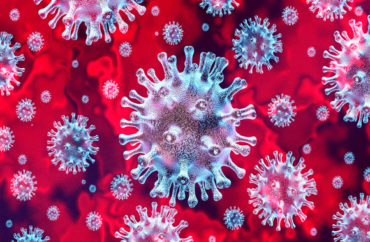
EDITOR’S NOTE: An expert in public health emergency preparedness who has advised the CDC, George Avery, submitted this essay to The College Fix. The former Purdue University professor of public health wants to express his agreement with “other professors of public health on the overreaction that is occurring” in response to the coronavirus pandemic.
Naive and sensationalist reporting on fatality rates from the novel coronavirus has contributed to toilet-paper hoarding, drastic crackdowns on civil rights by political figures, and potentially devastating and lasting economic impact.
Bloomberg News, for example, implied March 10 that 3.4 to 3.5 percent of infected individuals die. This has caused comparisons to the 1919 Influenza A:H1N1 pandemic and its 2.5 percent case fatality rate, which would qualify as a level 5 event on the CDC’s Pandemic Severity Index.
To a trained epidemiologist, however, this case fatality rate is obviously a significant overestimation of the actual fatality rate from SARS-CoV-2, which causes COVID-19.
Ascertainment bias is a systematic error in statistical estimation of a population parameter resulting from errors in measurement – usually, in undermeasurement of a parameter. In this case, we are underestimating the actual number of cases in the population, which is the denominator in the calculation of the estimated case fatality rate.
We are accurately estimating deaths, but to get the case fatality rate, we divide deaths by our estimate of the number of cases. Because that estimate is too low due to measurement error, the estimate of the case fatality rate is too high.
As an example, imagine a hypothetical disease with three deaths in 10 observed cases, giving us a case fatality rate of 30 percent. If, however, there were actually 300 cases, and only 10 were observed and reported, ascertainment bias has led us to underestimate the cases and overestimate the case fatality rate, which is actually 1 percent.
In the absence of population-based screening to more actually estimate the total number of COVID-19 cases, we are only counting cases who are sick enough to seek health care, since almost all disease reports are made by healthcare professionals.
We are missing people who have no more than a cold or who are infected but show no symptoms, individuals who almost certainly make up the overwhelming majority of actual cases. Thus, as in my hypothetical example, we are overestimating the case fatality rate for the disease.
There is, however, data available on COVID-19 that allows us to get a better grasp on the actual case fatality rates for the virus.
The cruise ship Diamond Princess achieved notoriety from the well-publicized outbreak among its 3,711 passengers and crew in January and February 2020. Held aboard in constricted quarters, the population was subject to 3,068 polymerase chain reaction tests.
It identified 634 individuals (17 percent) as infected, with over half of these infections producing no symptoms. Seven infected passengers died, all of them over the age of 70.
Adjusting this data for age, researchers at the London School of Hygiene and Tropical Medicine have estimated a fatality rate per infection for the epidemic in China of 0.5 percent with a 95 percent confidence interval of 0.2-1.2 percent during the same period. This is far below the earlier estimates of 3.4 percent or greater that were promoting panic.
South Korea has also implemented far wider population-based screening than the United States, expanding its screening past suspected cases to voluntary population screening in geographies frequented by identified cases.
As of March 15, as economist Richard Epstein of Stanford’s Hoover Institution has noted, South Korea performed more than 235,000 tests and identified 8,162 infections, with 75 deaths, or a case fatality rate of 0.91 percent. Again, only about 10 percent of the deaths were in the population under 60.
While far better than the U.S., this was still not a broad-based screening effort such as was used on the Diamond Princess. While it looked at a broader population, the South Korea screening was still biased by virtue of looking only at the segment of the population with a higher risk. Even so, the case fatality rate is significantly below the 3.4 percent rate that caused the public panic.
What we are likely seeing, in my estimation, is an epidemic with a real case fatality rate between 0.2 and 0.5 percent, which is similar to the 1957 Asian Influenza A:H2N2 or 1968 Hong Kong Influenza A:H3N2 pandemics. Those were also essentially virgin field respiratory epidemics.
These earlier pandemics were nowhere near as harmful as the 1919 Influenza A:H1N1 outbreak, with a PSI level 5, but rather rate as PSI level 2 events on the CDC scale. That’s enough to qualify as atypical and more severe than a routine seasonal flu epidemic (PSI level 1).
The 1956 and 1968 pandemics essentially tripled the number of deaths due to influenza experienced annually, yet were handled without the extreme measures that are currently being adopted or proposed by political figures, and posed little long-term economic or other damage to the population.
Like those pandemic events, COVID-19 has its most significant impact on elderly or otherwise compromised individuals, with few fatalities observed in the population under the age of 60. From what we have observed, half of those infected show no symptoms, 40 percent show mild symptoms such as a cold, and only about 2 percent advance to serious or critical illness.
What is needed now is for politicians and the population to pause, take a deep breath, and address the epidemic with rational measures, such as those strategized by myself and Purdue University colleagues in 2007 to ensure adequate capacity to deal with another true influenza pandemic.
These include social distancing of the older population, screening of those who have been in contact with identified cases, quarantine of identified infected individuals, and adequate hospital triage systems to protect other patients and health care staff from infection, in order to preserve our ability to treat the most severe cases.
Dr. Avery has a PhD in Health Services Research from the University of Minnesota School of Public Health. He has conducted significant research in the area of public health emergency preparedness, and served on Centers for Disease Control preparedness advisory boards. He is currently a research scientist with a medical analytics firm, was a professor with the public health program at Purdue University from 2005-2011, and worked from 1990-2000 with the Arkansas Department of Health’s Division of Public Health Laboratories.
IMAGE: Lightspring/Shutterstock
Like The College Fix on Facebook / Follow us on Twitter




Add to the Discussion